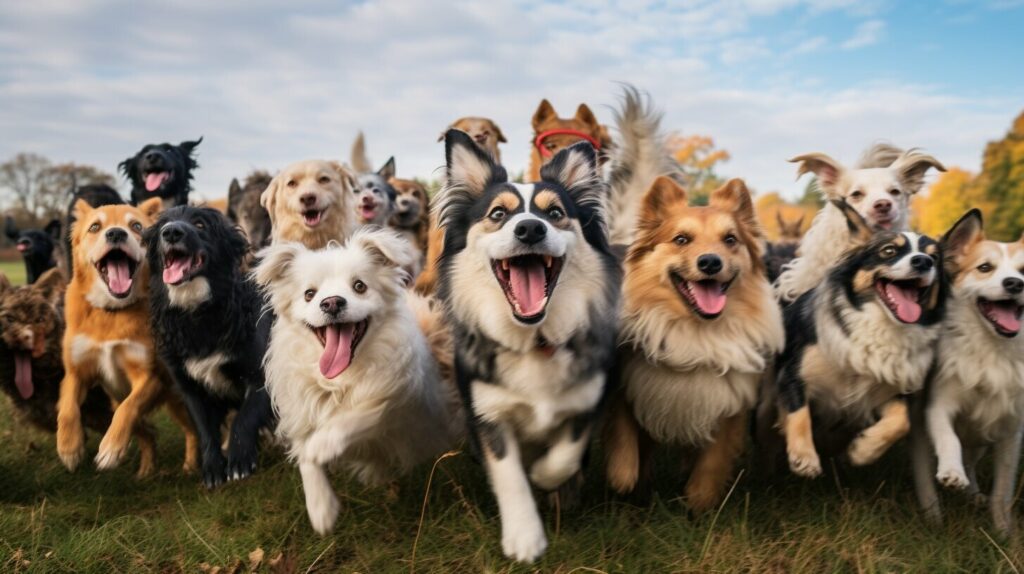If you have a scared dog, you know how heartbreaking it can be to see them suffer. Fear in dogs can manifest in a variety of ways, from shaking and panting to destructive behavior or aggression. Fortunately, there are practical strategies you can use to help your scared dog feel safer and more confident.
Key Takeaways:
- It’s important to understand the signs of fear and anxiety in dogs.
- Fear in dogs can have a variety of causes, including past trauma or lack of socialization.
- Creating a safe environment, positive reinforcement training, and natural remedies can all help manage fear and anxiety.
- Gradual exposure and exercise can help build confidence in scared dogs.
- Consulting a professional may be necessary in some cases.
Recognizing the Signs of Fear in Dogs
If you’re a dog owner, it’s important to be able to recognize the signs of fear in your furry friend. Fear is a natural and instinctual response for dogs, but when it becomes chronic or intense, it can be debilitating and distressing for both the dog and their owner.
Some common signs of fear in dogs include:
- Trembling or shaking
- Tail tucking
- Excessive panting or drooling
- Hiding or cowering
- Whimpering or growling
- Refusal to eat or drink
It’s important to note that fear in dogs can manifest in different ways, depending on the dog’s personality and previous experiences. For example, some dogs may become aggressive when they feel scared, while others may withdraw or shut down.
Recognizing Body Language
One of the best ways to tell if your dog is scared is to pay attention to their body language. Here are some common signs of fear:
| Body Part | Sign of Fear |
|---|---|
| Eyes | Wide open or darting around |
| Ears | Pinned back against the head |
| Tail | Tucked between the legs |
| Mouth | Pulled back or closed tightly |
| Body | Tense or hunched over |
Of course, every dog is different, and some may exhibit more subtle signs of fear than others. However, if you notice any of the above signs or anything out of the ordinary, it’s worth investigating further to determine if your dog is scared.
Understanding the Causes of Fear and Anxiety in Dogs
As a dog owner, it’s essential to recognize that fear and anxiety are common in dogs, and they can have significant impacts on their behavior and overall well-being. Understanding the potential causes of fear and anxiety in dogs can help you better manage their fears and support their emotional health.
Fear in Dogs: Fear is a natural and necessary response in dogs that helps them avoid danger and stay safe. However, excessive or irrational fear responses can lead to anxiety and behavioral issues. Dogs can develop fears of specific stimuli, such as loud noises, certain people or animals, or unfamiliar environments.
Anxiety in Dogs: Anxiety in dogs is a general feeling of unease or worry that can have constant or intermittent symptoms. Some common symptoms of anxiety in dogs include excessive barking, pacing or trembling, destructive behavior, or aggressive behavior. Anxiety in dogs can be caused by a variety of factors and can have significant impacts on their emotional and physical health.
Potential Causes of Fear and Anxiety in Dogs: Fear and anxiety in dogs can be caused by a range of factors, including past traumatic experiences, lack of socialization, or genetic predisposition. Dogs that have experienced abuse or neglect may be more prone to fear and anxiety. Additionally, dogs that have had limited exposure to different people, animals, and environments may have difficulty adjusting to new situations. Some dog breeds may also be predisposed to anxiety or fear responses.
It’s important to approach your scared dog with empathy and patience, recognizing that their fears are real and valid. By understanding the potential causes of fear and anxiety in dogs, you can take steps to manage their fears and support their emotional well-being.
Managing Scared Dogs: Creating a Safe Environment
When it comes to managing scared dogs, creating a safe and secure environment is key. This means identifying potential triggers that may cause fear and anxiety in your dog and taking steps to remove or minimize them.
Some dogs may be afraid of loud noises like thunderstorms or fireworks, while others may be scared of certain people or other animals. By identifying what triggers your dog’s fear response, you can take steps to prevent or avoid them as much as possible.
In addition to removing potential triggers, providing a designated safe space for your dog can also be helpful. This can be a crate, a specific room, or even a cozy bed or blanket that your dog feels comfortable and secure in.
Establishing routines and consistency can also help your scared dog feel more secure. This includes maintaining a consistent feeding and exercise schedule, as well as providing plenty of positive reinforcement and affection.
Helping Scared Dogs: Positive Reinforcement Training Techniques
If you have a scared dog, you know how challenging it can be to help them feel more comfortable and confident in their environment. Fortunately, positive reinforcement training techniques can be highly effective for helping scared dogs overcome their fears and build confidence.
Positive reinforcement training focuses on rewarding dogs for desired behaviors, rather than punishing them for undesirable ones. This type of training has been shown to be highly effective for a variety of behavioral issues and can be especially beneficial for scared dogs.
When training scared dogs, it’s important to start slowly and be patient. Rushing the process or expecting too much progress too soon can actually backfire and make the dog more fearful. Here are some tips for implementing positive reinforcement training:
- Use high-value treats, such as small pieces of boiled chicken or cheese, to reward desired behaviors.
- Break training sessions into short, manageable increments (5-10 minutes) to avoid overwhelming the dog.
- Start with simple commands, such as “sit” or “stay,” and gradually move on to more complex ones.
- Use consistent verbal cues and hand signals to help the dog understand what is expected of them.
- Avoid using punishment or physical force, as this can increase fear and anxiety in scared dogs.
Remember, every dog is unique and may respond differently to training. Be patient and adjust your approach as needed to best suit your dog’s needs.
Positive reinforcement training can be a powerful tool for helping scared dogs build confidence and overcome their fears. By using high-value treats, breaking training sessions into manageable increments, and avoiding punishment or physical force, you can help your scared dog feel more comfortable and at ease in their environment.
Calming Scared Dogs: Natural Remedies and Treatments
If your scared dog is struggling with anxiety, there are several natural remedies and calming treatments to consider.
Aromatherapy: Certain scents can have a calming effect on dogs, such as lavender or chamomile. You can use essential oils diluted in a diffuser or spray to help create a calming environment for your scared dog.
Pheromone Diffusers: These products mimic the pheromones that a mother dog releases to calm her puppies. Pheromone diffusers can help create a sense of security and comfort for your dog, especially in times of stress.
Herbal Supplements: There are several herbal supplements that can help reduce anxiety in dogs, such as valerian root or passionflower. It’s important to consult with your veterinarian before giving your dog any new supplement to ensure it’s safe and appropriate for your pet.
CBD Oil: Some pet owners have reported success in using CBD oil to calm their scared dogs. This natural supplement can help reduce anxiety and promote a sense of relaxation, but it’s important to consult with your veterinarian before trying any new treatment.
While natural remedies can be an effective tool in calming scared dogs, it’s important to use caution and consult with your veterinarian before trying any new treatments. Always monitor your dog’s reaction and adjust as needed to ensure their safety and comfort.
Building Confidence in Dogs: Gradual Exposure and Desensitization
To help your scared dog build confidence over time, gradual exposure and desensitization techniques can be effective. This involves slowly introducing your dog to their fears in a controlled and positive way, helping them to become more comfortable and confident.
Start by identifying your dog’s triggers and creating a plan to gradually introduce them in a safe and controlled environment. For example, if your dog is scared of other dogs, start by exposing them to dogs at a distance and increase the exposure gradually over time.
It’s important to reward your dog for positive behavior and progress throughout the desensitization process. This can be done through praise, treats, or toys to keep them motivated and focused on the task at hand.
Remember to be patient throughout the process and never force your dog into a situation they’re not ready for. By taking it slow and steady, you can help your scared dog build confidence and overcome their fears over time.
Incorporating Play and Exercise: Boosting Your Dog’s Confidence
Physical activity and playtime are crucial for building confidence in scared dogs. Engaging in interactive play and exercise can help your dog burn off excess energy, reduce stress and anxiety, and boost their self-esteem. Here are some tips for incorporating play and exercise into your dog’s routine:
- Interactive toys: Toys that require your dog to problem solve or work for a reward can be great for boosting confidence. Puzzle toys, treat dispensers, and tug-of-war ropes are all great options.
- Agility training: Agility training can help your dog improve their focus and control, while also providing physical exercise. Start with basic obstacles like jumps and tunnels, and gradually increase the difficulty as your dog becomes more confident.
- Obedience training: Simple obedience training exercises, like sit, stay, and come, can help your dog feel more in control and confident. Use positive reinforcement techniques to keep the training fun and engaging.
- Group activities: Socializing with other dogs in a safe and controlled environment can be great for building confidence. Consider enrolling your dog in a local doggy daycare or group training class.
Remember to always monitor your dog during playtime and adjust activities as needed to prevent over-stimulation or exhaustion. With patience and practice, you can help your scared dog become more confident and happy.
Seeking Professional Help: When to Consult a Dog Behaviorist
While many scared dogs can be helped with consistent training and a supportive environment, some may require professional assistance to overcome their fears. If you have tried various strategies and are still struggling to manage your dog’s anxiety, it may be time to consult with a dog behaviorist or trainer.
A dog behaviorist can help identify the underlying causes of your dog’s fear and anxiety and develop a personalized training plan to address these issues. They can also provide guidance and support to ensure that you are implementing the training correctly and effectively.
It is important to find a reputable and qualified professional who has experience working with scared dogs and uses positive reinforcement training methods. Look for someone who is certified by a recognized organization, such as the Certification Council for Professional Dog Trainers or the International Association of Animal Behavior Consultants.
Remember, seeking professional help is not a sign of failure or weakness. It is a proactive step towards helping your dog lead a happier, healthier, and more confident life.
Section 10: Conclusion
Congratulations! You have reached the end of this comprehensive guide on understanding and helping your scared dogs. We hope you have found the information provided useful and practical in your efforts to improve your dog’s confidence and well-being.
Remember, dealing with scared dogs can be a challenging process that requires patience, empathy, and consistency. However, with the right strategies and techniques, you can make a positive difference in your dog’s life.
Throughout this guide, we have highlighted the importance of recognizing the signs of fear in dogs, understanding the underlying causes of anxiety, creating a safe and secure environment, using positive reinforcement training, exploring natural remedies and treatments, gradual exposure and desensitization, incorporating play and exercise, and seeking professional help when needed.
By implementing these tips and strategies, you can help your scared dog overcome their fears and become a more confident and happy companion. Remember, every dog is unique, and what works for one may not work for another. Be patient, stay positive, and adapt your approach as needed.
Thank you for taking the time to learn about scared dogs, and we wish you and your furry friend all the best in your journey toward a brighter future.
FAQ
Q: What are the signs of fear in dogs?
A: Common signs of fear in dogs include trembling, tail tucking, excessive panting, and hiding. Some dogs may also display aggression or withdrawal when they are scared.
Q: What can cause fear and anxiety in dogs?
A: Fear and anxiety in dogs can be caused by factors such as past traumatic experiences, lack of socialization, or genetic predisposition.
Q: How can I create a safe environment for my scared dog?
A: To create a safe environment for a scared dog, it’s important to remove potential triggers, provide a designated safe space, and establish routines and consistency.
Q: How can I help a scared dog through positive reinforcement training?
A: Positive reinforcement training techniques, such as reward-based training, can be effective in helping scared dogs overcome their fears. It’s important to provide consistent rewards and praise for desired behaviors.
Q: Are there any natural remedies or treatments that can help calm scared dogs?
A: Yes, natural remedies such as aromatherapy, pheromone diffusers, or herbal supplements can help calm scared dogs. However, it’s always recommended to consult with a veterinarian before trying any new treatments.
Q: How can I build confidence in my scared dog?
A: Gradual exposure and desensitization techniques can help build confidence in scared dogs. This involves gradually exposing them to their fears in a controlled and positive way.
Q: How can play and exercise boost my dog’s confidence?
A: Engaging in interactive play, agility training, or other activities can boost a scared dog’s confidence by providing mental stimulation and physical exercise.
Q: When should I consult a dog behaviorist for my scared dog?
A: If you’re struggling to manage your scared dog’s behaviors or if their fear and anxiety are significantly impacting their quality of life, it may be beneficial to seek professional help from a dog behaviorist or trainer.
Q: What is the importance of patience, consistency, and empathy when working with scared dogs?
A: Patience, consistency, and empathy are crucial when working with scared dogs. Building trust and confidence takes time, and it’s important to approach training and assistance with understanding and compassion.



